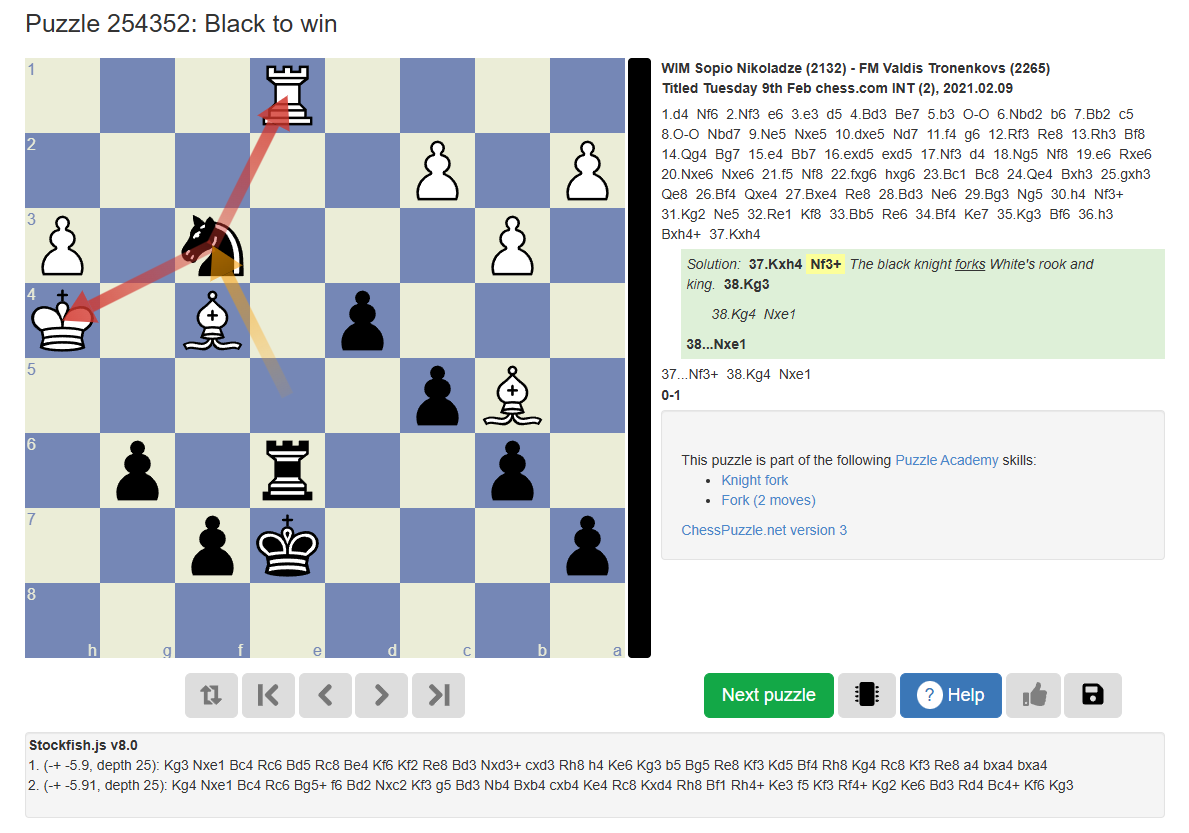About Ratings

About chess ratings
Players participating in international chess tournaments can get a rating from the international chess federation FIDE. The rating is called FIDE Elo, named after Arpad Elo, a strong chess player and physics professor, who invented this rating system. Many national chess federations and chess websites use a similar rating system.
When a game is rated, the ratings of both players are adjusted based on the result, and the players' previous ratings. The rating of the player winning the game increases, and the rating of the player who lost the game decreases. If you beat a stronger player, the increase is higher than if you beat a weaker player. The adjustments to a rating can also be bigger for new players, or for Junior players, than they are for experienced players.
About the ratings used on ChessPuzzle.net
On ChessPuzzle.net, every solver and every puzzle get a rating.
Solving a puzzle is rated like a game you play against the puzzle:
If you solve the puzzle correctly, you win the game - your rating increases, and the rating of the puzzle decreases.
If you play an incorrect move, you lose the game - your rating decreases, and the rating of the puzzle increases.
You can always see your rating on the top right of the screen next to your username. The ratings of the last puzzles you played is shown in the progress bar below the board. If you set the setting for automatically switching to the next puzzle to "Never", you can also see the rating changes after every puzzle you play. On your user profile page, you can see a graph of your rating over time.
Rating rules on ChessPuzzle.net
There are a few rules about ratings to keep it fair:
- If you solve a puzzle again, which you already solved in the past, the solving is unrated. Otherwise you could just solve the same puzzle again and again to increase your rating.
- Sometimes you solve a puzzle with a hint and already know the motif, for example when using the filter, or when unlocking a new skill in Puzzle Academy. In that case, the difficulty rating of the puzzle is different, as it can be significantly easier.
Typical ratings
On ChessPuzzle.net we try to balance the ratings so that they approximately match FIDE Elo ratings. That way your ChessPuzzle.net rating gives you an indication of your tactical strength.
The following table shows rating with a description:
| Rating | Description |
|---|---|
| <1000 | Beginner |
| >=1000 | Casual player |
| >=1200 | Club player |
| >=1400 | League player |
| >=1600 | Tournament player |
| >=1800 | Advanced player |
| >=2000 | Expert |
| >=2100 | Candidate master |
| >=2200 | National master |
| >=2400 | International master |
| >=2500 | Grandmaster |
| >=2700 | Super grandmaster |
| >=2800 | World champion |
| >=3000 | Super human |
Expected solving rates
If you have the same rating as the puzzle, you are expected to solve these puzzles 50% of the time.
The following table shows the difference in rating between player and puzzle, and the expected solving percentage:
| Rating difference | Expected solving percentage |
|---|---|
| -400 | 91% |
| -300 | 85% |
| -200 | 76% |
| -100 | 64% |
| 0 | 50% |
| +100 | 36% |
| +200 | 24% |
| +300 | 15% |
| +400 | 9% |
Other ratings
After you played a set of puzzles, for example in Puzzle Climb, we sometimes show a "performance" rating. That's a rating based on just the puzzles you solved in that run.
Puzzle Academy shows a rating for each of your skills. That's a rating based on you just solving the puzzles corresponding to that skill. It gives you an indication of your strengths and weaknesses, taking the difficulties of the puzzles into account.
Learn more
You can learn more about chess ratings and the Elo rating system on Wikipedia.

Wednesday, January 26, 2022
Martin Bennedik
Founder of ChessPuzzle.net, International Correspondence Chess Master
Related posts
The ChessPuzzle.net settings dialog
This article explains all options of the settings dialog.Quick Guide to the Solution View
In this post, we will give you a quick guide to the solution view. The solution view gives you a chance to get a deeper understanding of the solution to the puzzles. If you failed a puzzle it is a good chance to learn and explore why your solution didn’t work.

